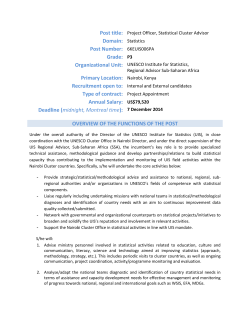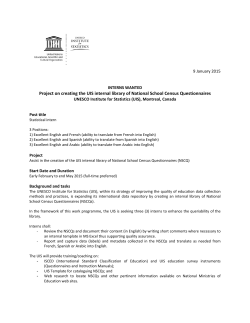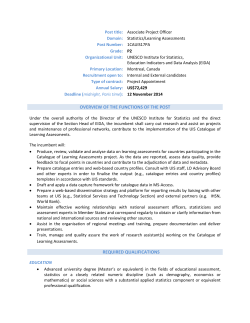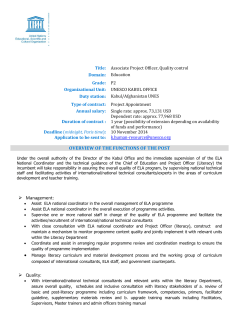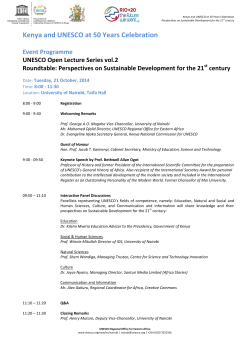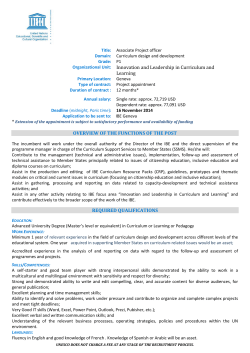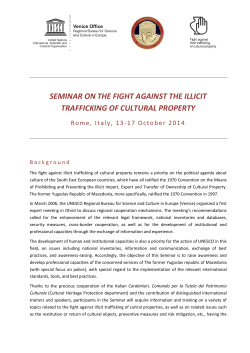
Introduction to the Oslo Manual: main definitions (Part I)
Introduction to the Oslo Manual: main definitions (Part I) ECO - UIS Regional Workshop on Science, Technology and Innovation (STI) Indicators Tehran, Iran 8-10 December 2013 Luciana Marins, UIS www.uis.unesco.org Measuring Innovation Oslo Manual: Guidelines for collecting and interpreting innovation data UIS - Annex (OM, 2005): Innovation Surveys in Developing Countries www.uis.unesco.org Why measure innovation? Innovation and economic development; Innovation is more than R&D; Innovation policy should be evidence-based; Innovation data… • Understanding of innovation and its relation to economic growth; • Indicators for benchmarking national performance. www.uis.unesco.org What is innovation? Innovation is the implementation of: • New or significantly improved product or process; • New marketing or organisational method. Implementation: A new or improved product is implemented when it is introduced on the market; New processes, marketing methods or organisational methods are implemented when they are brought into actual use in the firm’s operations. www.uis.unesco.org The innovation measurement framework www.uis.unesco.org Types of innovation - Product (1) Product Innovation: • Introduction of a good or service that is new or significantly improved with characteristics or intended uses; respect to its • New products: different characteristics or intended uses from previous products; • Significantly improvements: changes in materials, components, and other characteristics that enhance performance. www.uis.unesco.org Types of innovation - Product (2) Product Innovation - examples: • New products: » The first microprocessors; » The first digital cameras; » The first portable MP3 player; • Significantly improvements: » Introduction of ABS braking, GPS navigational systems, or other subsystem improvements in cars; » The use of breathable fabrics in clothing; » Improvements in internet banking services, such as greatly improved speed and ease of use. www.uis.unesco.org Types of innovation - Process (1) Process Innovation: • Implementation of a new or significantly improved production or delivery method (changes in techniques, equipment and/or software); • Intended to: decrease unit costs of production or delivery, increase quality, or produce or deliver new or significantly improved products. www.uis.unesco.org Types of innovation - Process (2) Process Innovation - examples: » Introduction of a bar-coded goods-tracking system; » Introduction of GPS tracking devices for transport services; » Implementation of computer-assisted design for product development; » Implementation of a new reservation system in a travel agency. www.uis.unesco.org Types of innovation - Marketing (1) Marketing Innovation: • Implementation of a new marketing method involving significant changes in product design or packaging, product placement, product promotion or pricing; • Better addressing customer needs, opening up new markets, or newly positioning a firm’s product on the market increasing firm’s sales; • Marketing method NOT previously used - part of a new marketing concept or strategy; • For both new and existing products. www.uis.unesco.org Types of innovation - Marketing (2) Marketing Innovation: • Product design or packaging: changes in form and appearance that do not alter products’ functional or user characteristics + changes in the packaging; • Product placement: new sales channels; • Product promotion: new concepts for promoting firms’ goods and services; • Pricing: new pricing strategies to market the firms’ goods or services. www.uis.unesco.org Types of innovation - Marketing (3) Marketing Innovation - examples: » Development and introduction of a fundamentally new brand symbol; » First use of a significantly different media - product placement in a television programme; » Introduction for the first time of a franchising system. www.uis.unesco.org Types of innovation - Organisational (1) Organisational Innovation: • Implementation of a new organisational method in the firm’s business practices, workplace organisation or external relations; firm’s performance by reducing administrative/transaction costs, improving workplace satisfaction, accessing non-tradable assets, or reducing costs of supplies; • Increase • Organisational method NOT used before - result of strategic decisions taken by management. www.uis.unesco.org Types of innovation - Organisational (2) Organisational Innovation: • Business practices: implementation of new methods for organising routines and procedures for the conduct of work; • Workplace organisation: new methods for distributing responsibilities and decision making among employees for the division of work within and between firm activities + new concepts for the structuring of activities; • External relations: new ways of organising relations with other firms or public institutions. www.uis.unesco.org Types of innovation - Organisational (3) Organisational Innovation - examples: » First implementation of a database of best practices; » Establishment of new types of collaborations with research organisations; » First implementation of an organisational model that gives the firm’s employees greater autonomy in decision making and encourages them to contribute their ideas. www.uis.unesco.org Diffusion and degree of novelty Degree of novelty: • Firm; • Market; • World. www.uis.unesco.org Example - product innovation/degree of novelty During the three years 200X to 200Y, did your enterprise introduce: (Product innovations) New or significantly improved goods? New or significantly improved services? Yes () () No () () Were any of your product innovations during the three years 200X to 200Y: (Degree of novelty) New to your market? Only new to your firm? Yes () () No () () www.uis.unesco.org Example - organisational innovation During the three years 200X to 200Y, did your enterprise introduce: (Organisational innovations) New business practices for organising procedures New methods of organising work responsibilities and decision making New methods of organising external relations with other firms or public institutions Yes No () () () () () () www.uis.unesco.org Types of innovation - example Innovation in a restaurant: • Product innovation: delivery (new service); • Process innovation: new type of oven (new equipment used in the production process); • Organisational innovation: new delivery unit (new organisational unit/model); • Marketing innovation: billposting (new media for promoting the delivery service). Note. Source: Adapted from Heinlo, A. (2011). Measuring R&D&I in Estonia. Almaty, Kazakhstan S&T Indicators Workshop. (PowerPoint Presentation) www.uis.unesco.org Thank you! http://www.uis.unesco.org l.marins@unesco.org www.uis.unesco.org Exercise… Exercise 1: Types of Innovation www.uis.unesco.org
© Copyright 2025
